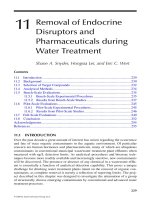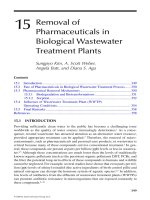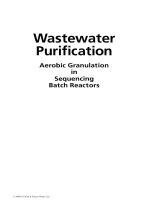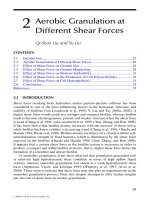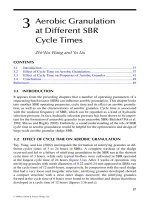Wastewater Purification: Aerobic Granulation in Sequencing Batch Reactors - Chapter 8 doc
Bạn đang xem bản rút gọn của tài liệu. Xem và tải ngay bản đầy đủ của tài liệu tại đây (395.96 KB, 17 trang )
131
8
Diffusion of Substrate
and Oxygen in
Aerobic Granules
Yong Li, Zhi-Wu Wang, and Yu Liu
CONTENTS
8.1 Introduction 131
8.2 Size-Dependent Kinetic Behaviors of Aerobic Granules 132
8.3 Description of Diffusion Resistance in Aerobic Granules 133
8.4 Simulation of Mass Transfer in Aerobic Granules 135
8.4.1 Model Development 136
8.4.2 Substrate Prole in Aerobic Granules with Different Radiuses 139
8.4.3 Oxygen Proles in Aerobic Granules with Different Radiuses 139
8.4.4 Diffusion Proles of Substrate in Aerobic Granules at
Different Bulk Substrate Concentrations 139
8.4.5 DiffusionProlesofDissolvedOxygeninAerobicGranulesat
Different Substrate Concentrations 141
8.4.6 Prediction of Bulk Substrate Concentration in an Aerobic
Granules Reactor 143
8.5 Conclusions 144
Symbols 145
References 146
8.1 INTRODUCTION
Up-to-date, intensive research has been dedicated to the effect of various operating
parameters on aerobic granulation in sequencing batch reactors (SBRs) (chapters 1
to7).However,verylimitedinformationiscurrentlyavailableaboutthediffusion
behaviorsofsubstancesinsideaerobicgranules.Tayetal.(2002)foundthatamodel
dye was only able to penetrate 800 μm beneath the surface of aerobic granules, while
Jangetal.(2003)reportedapenetrationdepthof700μmfordissolvedoxygenfrom
the surface of aerobic granules. Meanwhile, oxygen diffusion limitation in nitrifying
aerobic granules was detected by microelectrode (Wilen, Gapes, and Keller 2004).
Moreover,theunbalancedmicrobialgrowthinsideaerobicgranuleshasbeensup-
posedtobeduetothemassdiffusionlimitationinaerobicgranules,whichwould
furtherleadtoaheterogeneousinternalstructure(seechapter11).Theseindicate
53671_C008.indd 131 10/29/07 7:19:50 AM
© 2008 by Taylor & Francis Group, LLC
© 2008 by Taylor & Francis Group, LLC
132 Wastewater Purification
that without a proper control of the mass diffusion, the structural stability of aerobic
granules might not be sustainable.
Inviewoftheimportanceofsubstrateandoxygeninmicrobialculture,this
chapterattemptstoofferinsightsintothediffusionbehaviorsofsubstrateandoxy
-
geninaerobicgranules.Thefactorsthatdeterminetheirrespectivediffusioninaero
-
bic granules are also discussed, with special focus on the reactor operation as well as
aerobic granule characteristics.
8.2 SIZE-DEPENDENT KINETIC BEHAVIORS OF
AEROBIC GRANULES
Massdiffusionlimitationoftenoccursinattachedmicrobialcommunities,suchas
biolms, and it suppresses microorganisms from fully accessing the substrate and
oxygeninbulksolution.Asaresult,themicrobialactivityisloweredbydeciency
oftheenergysource.Toinspecttheexistenceofmassdiffusionlimitationinaerobic
granules,Y.Q.Liu,Liu,andTay(2005)determinedthespecicCODremovalrates
andspecicgrowthratesofaerobicgranuleswithdifferentsizes.Itappearsfrom
gure8.1thatthespecicCODremovalratedecreasedmarkedlywiththeincrease
inthesizeofaerobicgranules,indicatingthatthemicrobialactivityinsideaerobic
granulesisinhibitedasthegranulesizeincreases.Moreover,thespecicgrowthrate
ofaerobicgranuleswasinverselydependentonthegranulesize(gure8.2).Aplotof
the specic growth rate against the specic substrate utilization rate further reveals
thattheslowsubstrateutilizationbylarge-sizedaerobicgranulesresultsinalow
specicgrowthrate(gure8.3).Sucharelationshipbetweenthespecicgrowthand
substrate utilization rates is consistent with the prediction by microbial growth theory
(MetcalfandEddy2003).Consequently,thekineticbehaviorsofaerobicgranules
depictedbythespecicgrowthandsubstrateutilizationratesaresizedependent.
$&)!#"('%
*
FIGURE 8.1 Granule size-dependent specic chemical oxygen demand (COD) removal
rate.(DatafromLiu,Y.Q.,Liu,Y.,andTay,J.H.,2005.Lett Appl Microbiol 40:
312–315.)
53671_C008.indd 132 10/29/07 7:19:51 AM
© 2008 by Taylor & Francis Group, LLC
© 2008 by Taylor & Francis Group, LLC
Diffusion of Substrate and Oxygen in Aerobic Granules 133
8.3 DESCRIPTION OF DIFFUSION RESISTANCE IN
AEROBIC GRANULES
Itappearsfromgures8.1and8.2thattheobservedkineticbehaviorsofaerobic
granules with different sizes is ultimately the result of diffusion limitation of sub-
strate or oxygen in aerobic granules. In order to look into this, Y. Q. Liu, Liu, and Tay
(2005) introduced the concept of an effectiveness factor (I), which can be calculated
as follows:
H
rate with diffusion limitation
rate withou
tt diffusion limitation
(8.1)
#"!!
$
FIGURE 8.2 Granule size-dependent specic biomass growth rate of aerobic granules. (Data
fromLiu,Y.Q.,Liu,Y.,andTay,J.H.2005.Lett Appl Microbiol 40: 312–315.)
Specific COD Removal Rate (h
–1
)
0.09 0.12 0.15 0.18 0.21 0.24 0.27 0.30
Specific Biomass Growth Rate (h
–1
)
0.015
0.020
0.025
0.030
0.035
0.040
0.045
FIGURE 8.3 Specic growth rate of aerobic granules versus specic substrate utilization
rate;datafromgures8.1and8.2.
53671_C008.indd 133 10/29/07 7:19:54 AM
© 2008 by Taylor & Francis Group, LLC
© 2008 by Taylor & Francis Group, LLC
134 Wastewater Purification
Inacasewherediffusionlimitationisnegligible,I approaches unity, while I
is close to zero if the diffusion limitation becomes signicant as compared to the
reaction. Figure 8.4 shows that the
I tended to drop quickly with the increase of the
granuleradius.Thiswouldresultfromthepresenceofmassdiffusionlimitationin
large aerobic granules.
The Thiele modulus is a measurement of the ratio of granule surface reaction rate
tothemassdiffusionrate.IftheMonodkineticsformicrobialreactionisapplied,Y.
Q. Liu, Liu, and Tay (2005) proposed the following modied Thiele modulus (
K)by
introducing dimensionless concentrations:
F
M
R
X
YSD
om
XS o es
()
/12
(8.2)
TheThielemoduluscombinestheindividualeffectofspecicgrowthrate
Mm,
granule radius
R, initial biomass X
0
, substrate concentrations S
0
, anddiffusivityof
substrate
D
es
in granules. Obviously, a high G value means high surface reaction
rateandlowdiffusionrate,andviceversa.Aquasi-linearrelationshipoftheThiele
modulustothegranulesizesisshowningure8.5.Thisseemstoindicatethatthe
massdiffusiondominatesthesurfacereactionandbecomeslimitinginlargeaerobic
granules. Under similar cultivation conditions of granules, Tay et al. (2003) also
reportedthatsmallgranuleswithradiusofapproximately300μmconsistedentirely
oflivebiomass.Ascanbeseeningure8.5,averylowThielemoduluswasfoundin
aerobicgranuleswitharadiusof300μm,thatis,themicrobialreactionisdominant
over diffusion resistance in granules, and maintained the live cells throughout the
entire aerobic granules. In contrast, Tay et al. (2002) detected an anaerobic layer at
adepthof800to900μmfromthesurfaceofaerobicgranulesbytheuorescence
$"#!"%
FIGURE 8.4 Effectiveness factor versus (I) the radius of aerobic granule. (Data from
Liu,Y.Q.,Liu,Y.,andTay,J.H.2005.Lett Appl Microbiol 40: 312–315.)
53671_C008.indd 134 10/29/07 7:19:56 AM
© 2008 by Taylor & Francis Group, LLC
© 2008 by Taylor & Francis Group, LLC
Diffusion of Substrate and Oxygen in Aerobic Granules 135
in situ hybridization (FISH) method. This suggests that the oxygen diffusion became
the rate limiting factor over microbial reaction, which is evidenced by a large Thiele
modulus,asshowningure8.5.
Picioreanu, van Loosdrecht, and Heijnen (1998) reported that a porous,
mushroom-like,loosebiolmstructurewasobservedatalowmasstransferrate,
while the biolm structure was compact and smooth at increased mass transfer rates.
In general, the radius of aerobic granules is bigger than the thickness of biolm, thus
theeffectofmasstransferresistanceonthestructureofaerobicgranulesisremark
-
able.Itappearsfromequation8.2thatmasstransferresistanceinaerobicgranules
is closely related to the radius of the aerobic granules, the maximum specic growth
rate,initialbiomass,andsubstrateconcentrationsanddiffusivityofthesubstrate.
So far, it has been reported that selection of slow-growing bacteria and increase of
shearratefavorstheformationofcompactandstableaerobicgranules(Tay,Liu,and
Liu2001;Y.Liu,Yang,andTay2004).Obviously,slow-growingbacteriahavesmall
specic growth rates, leading to small-sized granules. According to equation 8.2,
a small value of the Thiele modulus can be expected in this case, that is, the mass
transfer resistance in this kind of aerobic granule would be lowered. Similarly,
smallaerobicgranulescanbecultivatedatrelativelyhighshearforce,andthisin
turnresultsinalowvalueoftheThielemodulus(equation8.2).Infact,theThiele
modulus and the effectiveness factor have been widely applied in biolm research
for decades. These two parameters also can provide useful information for quantita
-
tively understating the mass transfer resistance in aerobic granules.
8.4 SIMULATION OF MASS TRANSFER IN AEROBIC GRANULES
Mass transfer limitation has been observed in aerobic granules. The modeling
ofthesubstratediffusioninbiolmshasbeenwellstudied,forexample,aone-
dimensionalmodelforbiolmshasbeenproposedbyWannerandGujer(1986),and
Radius of Aerobic Granule
0 200 400 600 800 1000 1200 1400
iele Modulus
0.0
0.2
0.4
0.6
0.8
1.0
1.2
1.4
1.6
1.8
FIGURE 8.5 Thielemodulusversusradiusofaerobicgranule.(DatafromLiu,Y.Q.,
Liu, Y., and Tay, J. H. 2005. Lett Appl Microbiol 40: 312–315.)
53671_C008.indd 135 10/29/07 7:19:58 AM
© 2008 by Taylor & Francis Group, LLC
© 2008 by Taylor & Francis Group, LLC
136 Wastewater Purification
a three-dimensional model reecting the heterogeneous structures of biolms was
alsoestablishedbyPicioreanu,vanLoosdrecht,andHeijnen(1998).Basedonthe
study of biolm, Li and Liu (2005) investigated the description of diffusion process
in aerobic granules.
8.4.1 MODEL DEVELOPMENT
Matureaerobicgranuleshaveanequilibriumorstablesizewhengrowthanddetachment
forcesarebalanced(Y.LiuandTay2002).Inthedevelopmentoftheone-dimensional
model for aerobic granules, Li and Liu (2005) made the following assumptions:
1. An aerobic granule is isotropic in physical, chemical, and biological prop
-
erties,suchasdensityanddiffusioncoefcient
2. An aerobic granule is ideally spherical
3. No nitrication and anaerobic degradation happen in the process
4. Aerobic granules respond to the change of bulk substrate concentration so
quickly that the response time can be ignored
AccordingtoBaileyandOllis(1986),themassbalanceequationsbetweenthetwo
layers whose radiuses are, respectively,
r and r + dr canbeexpressedasfollows:
D
ds
dr
r
ds
dr
s
2
2
2
¥
§
¦
´
¶
µ
N (8.3)
in which
O is the substrate conversion rate, s is the substrate concentration, and D
s
is
thediffusioncoefcient.IntheapproachbyLiandLiu(2005),thesubstrateconver-
sionratewasgivenbytheMonod-typeequation:
N
R
M
x
xs s
Y
s
Ks
/
max
(8.4)
in which
S
x
is the biomass density, Y
x/s
is the biomass yield, and N and N
max
are the
specic growth rate and the maximum specic growth rate, respectively. Substituting
equation8.4intoequation8.3leadstothefollowingexpression:
D
ds
dr
r
ds
dr
s
KsY
s
s
x
xs
2
2
2
¥
§
¦
´
¶
µ
MR
max
/
(8.5)
Itwasassumedthatthederivativeatthecenterofthegranuleiszeroandthe
substrate concentration at the surface of the granule equals the bulk solution (Li and
Liu2005),thatis:
ds
dr
r
0
0(8.6)
53671_C008.indd 136 10/29/07 7:20:01 AM
© 2008 by Taylor & Francis Group, LLC
© 2008 by Taylor & Francis Group, LLC
Diffusion of Substrate and Oxygen in Aerobic Granules 137
sS
rR
bulk
(8.7)
Perez,Picioreanu,andvanLoosdrecht(2005)appliedequation8.5tothestudyof
spherical biolms, and analytically solved this equation by assuming that the growth
rateiszero-orderorrst-order.AsnotedbyLiandLiu(2005),suchasimplied
treatment of equation 8.5 leads to the inaccuracy of the prediction, and also limits
theapplicationofthisequationtoaverynarrowrange.Asequation8.5isanon-
homogenousequation,anumericalmethodtosolveitcompletelywasdeveloped
withoutanyassumptiononit(LiandLiu2005).Thismethodisbasedonthenite
differencemethod(FDM)(Hoffman2001).Theradiusisthusdividedinto
n grids,
that is:
D
ss s
r
ss
rr
s
s
ii iii
¥
§
¦
´
¶
µ
11
2
11
2
$
$
M
max ii
si
x
xs
KsY
R
/
(8.8)
This numerical scheme is applied to all situations without simplifying assump
-
tionsandthereforetheaccuracyisincreased.TheprogramwaswritteninMatlab™
languageandrununderMatlab7.0whichallowsaneasyvisualizationofthesimu
-
lated data (Li and Liu 2005). It should be emphasized that equation 8.8 can also be
appliedtooxygenifthesetofparametersforthesubstrateisreplacedwiththesetof
parameters for dissolved oxygen.
After the substrate concentration is determined, the substrate utilization rate (
O
1
)
ofasingleaerobicgranulecanbecalculatedas:
NRM
1
2
0
1
4
°
Y
srdr
xs
x
R
/
(8.9)
Summingupthesubstrateutilizationrateofalltheaerobicgranulesgivesthe
total substrate utilization rate
O
all
:
NRM
all
xs
x
R
i
m
Y
srdr
i
°
¤
1
4
2
0
1
/
(8.10)
in which
m is the number of aerobic granules in the reactor and R
i
is the radius of
thegranulebeingcalculated(LiandLiu2005).AccordingtoLiandLiu(2005),the
average radius
R of aerobic granules can be expressed as follows:
R
m
R
i
i
m
¤
1
1
(8.11)
53671_C008.indd 137 10/29/07 7:20:06 AM
© 2008 by Taylor & Francis Group, LLC
© 2008 by Taylor & Francis Group, LLC
138 Wastewater Purification
Substituting equation 8.11 into equation 8.10 yields:
NRM
all
xs
x
R
m
Y
srdr
°
/
4
2
0
(8.12)
Afterdeformation,equation8.12becomes:
N
PR
M
P
all
x
xs
R
Rm
Y
sr
R
dr
°
4
3
4
43
2
3
0
/
/
(8.13)
in which
4
3
PRRm
x
isequaltothetotalbiomassinthereactor.Thus,equation8.13
can be simplied to:
N
M
P
all
xs
R
XV
Y
sr
R
dr
°
/
/
4
43
2
3
0
(8.14)
in which
V is the reactor volume. At time dt, the change of substrate concentration in
the reactor can be described as:
dS
V
dt
X
Y
sr
R
drdt
bulk
all
xs
R
°
N
M
P
/
/
4
43
2
3
0
(8.15)
Inatimeperiodfrom
T
0
to T, the change in the substrate concentration is given
by equation 8.16:
$S
X
Y
sr
R
dr
bulk
xs
R
T
T
¥
§
¦
¦
´
¶
µ
µ
°°
/
/
M
P
4
43
2
3
0
0
ddt
(8.16)
At an initial substrate concentration,
S
bulk 0
, the bulk substrate concentration at
any time t can be calculated as:
SS S
S
X
Y
sr
bulk bulk bulk
bulk
xs
0
0
2
4
43
$
/
/
M
PRR
dr dt
R
T
T
3
0
0
°°
¥
§
¦
¦
´
¶
µ
µ
(8.17)
Asdiscussedearlier,equation8.17cannotbesolvedanalytically,andthemethod
basedonthenitedifferenceprincipleisthusappliedtosolvethisequation(Liand
Liu 2005). At each time step, the state is considered pseudo-static, which means the
bulk substrate concentration is constant at each time step. Then change of the bulk
substrate concentration is a process of mapping, that is, the substrate concentration
is determined by the previous time step. This model is valid for different substrates
53671_C008.indd 138 10/29/07 7:20:12 AM
© 2008 by Taylor & Francis Group, LLC
© 2008 by Taylor & Francis Group, LLC
Diffusion of Substrate and Oxygen in Aerobic Granules 139
so long as the parameters are replaced with the specic substrate parameters. In this
study,equation8.8wasappliedtoorganicsubstrateanddissolvedoxygenundervari-
ous operation conditions.
8.4.2 SUBSTRATE PROFILE IN AEROBIC GRANULES WITH DIFFERENT RADIUSES
LiandLiu(2005)simulatedthesubstrateprolesinbioparticleswithameansize
of0.1to1.0mm,andtheinitialacetateconcentrationandgranulebiomassconcen
-
trationwerekeptat465mgCODL
–1
and 6250 mg L
–1
volatile solids, respectively,
while the initial DO concentration was controlled at 8.3 mg L
–1
.Modelpredictions
showthattheacetateintermsofCODisabletopenetratetothecenterofallsizesof
aerobic granules, and the microbial utilization of COD was able to proceed through
-
CODprolesingure8.6ctoeshowtheplatformsbeneaththedepthsof0.23,0.11,
and 0.07 mm from the surface of aerobic granules with radiuses of 0.5, 0.75, and
1.0mm,respectively.Asassumed,thereshouldbenoautotrophicbacteriainaerobic
granule,thustheseCODplatformsingure8.6ctoeseemtoimplythatbacteriaat
thoseplatformdepthsoftheaerobicgranuleshouldhaveceasednormalmetabolic
activity. Furthermore, the noticeable level of COD present at those granule centers
points to another possibility accounting for the lowered microbial activity, that is,
dissolvedoxygencouldbealimitingfactoratthosedepths(gure8.6ctoe).
8.4.3 OXYGEN PROFILES IN AEROBIC GRANULES WITH DIFFERENT RADIUSES
Oxygenprolesinaerobicgranuleswithradiusesof0.1to1.0mmaresimulated
(gure8.7).SimilartotheCODprolesingure8.6,oxygencandiffuseintothe
entireaerobicgranuleswithradiusof0.1and0.4mm(gure8.7aandb).Foraerobic
granuleswitharadiusbiggerthan0.5mm,prominentoxygendiffusionlimitation
turnsout.Oxygenisonlyabletopenetrateto0.27,0.64,and0.1mmfromthesur
-
faceofaerobicgranuleswithradiusesof0.5,0.75,and1.0mm,andtheremaining
depth in the aerobic granule is decient in dissolved oxygen (DO) (gure 8.7c, d,
and e). Zero DO depths inside the aerobic granules are in good agreement with those
CODplatforms(gure8.6ctoe),andmicrobialactivityatthedepthofthoseCOD
platformswasseriouslylimitedbytheavailabilityofDO.
The DO-reachable depths shown in gure 8.7 appear to be inversely related to
thesizeoftheaerobicgranule.Thissuggeststhatlargeraerobicgranuleswillbe
subjectedtoanevenmoreseverediffusionlimitationofDOandfurthercauseadrop
inmicrobialactivity.Itcanthusbeconcludedthat,inlargeaerobicgranules,acetate
ororganicsubstratewouldnotbealimitingfactor,andthewholemicrobialprocess
wouldbedominatedbytheavailabilityofDOinsidetheaerobicgranule.
8.4.4 DIFFUSION PROFILES OF SUBSTRATE IN AEROBIC GRANULES AT
D
IFFERENT BULK SUBSTRATE CONCENTRATIONS
The results presented in gures 8.6 and 8.7 were obtained at a xed bulk COD con-
centration of 465 mg L
–1
, the effect of bulk COD concentration on the mass diffusion
in aerobic granule is not taken into account. In order to clarify this point, the COD
53671_C008.indd 139 10/29/07 7:20:13 AM
© 2008 by Taylor & Francis Group, LLC
© 2008 by Taylor & Francis Group, LLC
outaerobicgranuleswiththeradiusof0.1to0.4(gure8.6aandb).Incontrast,the
140 Wastewater Purification
prolesinanaerobicgranulewithradiusof0.5mmweresimulatedatdifferentbulk
COD concentrations of 100, 200, and 300 mg L
–1
,respectively(LiandLiu2005).
Figure8.8showssolubleCODcanpenetratethroughtheentireaerobicgranuleat
abulkCODconcentrationof300mgL
–1
or above, while COD becomes a limiting
factor and sharply drops to nil at depths of 0.25 and 0.1 mm at the bulk COD con
-
centrationsof100and200mgL
–1
, respectively. This suggests that COD availability
mayalsobealimitingfactorformicrobialgrowthatlowconcentrations,andthisis
stronglydependentonthelevelofexternalsubstrateconcentrationinbulksolution.
Radius (mm)
0.00 0.02 0.04 0.06 0.08 0.10
COD (mg L
–1
)
0
200
400
600
800
1000
COD (mg L
–1
)
0
200
400
600
800
1000
COD (mg L
–1
)
0
200
400
600
800
1000
COD (mg L
–1
)
0
200
400
600
800
1000
COD (mg L
–1
)
0
200
400
600
800
1000
Radius (mm)
0.0 0.1 0.2 0.3 0.4
0.0 0.1 0.2 0.3 0.4 0.5 0.00 0.25 0.50 0.75
(a) (b)
Radius (mm)
(c)
Radius (mm)
(d)
0.0 0.2 0.4 0.6 0.8 1.0
Radius (mm)
(e)
FIGURE 8.6 Substrateprolesinaerobicgranuleswithradiusesof0.10(a),0.40(b),
0.50 (c), 0.75 (d), and 1.00 mm (e). (Data from Li, Y. and Liu, Y. 2005. Biochem Eng J
27: 45–52.)
53671_C008.indd 140 10/29/07 7:20:15 AM
© 2008 by Taylor & Francis Group, LLC
© 2008 by Taylor & Francis Group, LLC
Diffusion of Substrate and Oxygen in Aerobic Granules 141
8.4.5 DIFFUSION PROFILES OF DISSOLVED OXYGEN IN
A
EROBIC GRANULES AT DIFFERENT SUBSTRATE CONCENTRATIONS
Oxygenprolesatdifferentacetateconcentrationsinaerobicgranuleswithradiusof
0.5mmareshowningure8.9.Itcanbeseenthatoxygencanpenetratetothecenter
of aerobic granules at low bulk COD concentrations of 100 and 200 mg COD L
–1
.
However,itcanonlydiffusetothedepthof0.38mmfromthesurfaceofaerobic
granules at the bulk COD of 300 mg L
–1
. This means that either DO or COD can be
Radius (mm)
(c)
Radius (mm)
(d)
0.0 0.1 0.2 0.3 0.4 0.5
Radius (mm)
(a)
0.00 0.02 0.04 0.06 0.08 0.10
Radius (mm)
(b)
0.0 0.1 0.2 0.3 0.4
0.00 0.25 0.50 0.75
Radius (mm)
(f)
0.0 0.2 0.4 0.6 0.8 1.0
DO (mg L
–1
)
0
2
4
6
8
10
DO (mg L
–1
)
0
2
4
6
8
10
DO (mg L
–1
)
0
2
4
6
8
10
DO (mg L
–1
)
0
2
4
6
8
10
DO (mg L
–1
)
0
2
4
6
8
10
FIGURE 8.7 Oxygen proles in aerobic granules with radiuses of 0.10 (a), 0.40 (b), 0.50 (c),
0.75(d),and1.00mm(e).(DatafromLi,Y.andLiu,Y.2005.Biochem Eng J 27: 45–52.)
53671_C008.indd 141 10/29/07 7:20:17 AM
© 2008 by Taylor & Francis Group, LLC
© 2008 by Taylor & Francis Group, LLC
142 Wastewater Purification
alimitingfactorformicrobialgrowthinaerobicgranules,whichstronglydepends
on the relative level of bulk COD concentration to DO, that is, a high bulk COD
would cause DO limitation in aerobic granules, and COD limitation would become
dominant at low bulk COD concentrations.
Most previous research on aerobic granulation investigated the proles of DO
and substrate separately (Tay et al. 2002; Jang et al. 2003; Wilen, Gapes, and Keller
2004).However,thefactthatoxygenproleinsideanaerobicgranuleisdynamic
and is closely related with substrate prole and metabolic activity has been ignored
Radius (mm)
0.0 0.1 0.2 0.3 0.4 0.5
DO (mg l
–1
)
0
2
4
6
8
10
FIGURE 8.9 Substrate proles in aerobic granules with a radius of 0.5 mm at bulk COD
of100(—),200(–––),and300(—·—)mgL
–1
.(DatafromLi,Y.andLiu,Y.2005.Biochem
Eng J 27: 45–52.)
FIGURE 8.8 Substrate proles in aerobic granules with a radius of 0.5 mm at bulk COD
of 100 (—), 200 (– – –), and 300 mg L
–1
(—·—).(DatafromLi,Y.andLiu,Y.2005.Biochem
Eng J 27: 45–52.).
53671_C008.indd 142 10/29/07 7:20:19 AM
© 2008 by Taylor & Francis Group, LLC
© 2008 by Taylor & Francis Group, LLC
Radius (mm)
0.0 0.1 0.2 0.3 0.4 0.5
COD (mg L
–1
)
0
100
200
300
Diffusion of Substrate and Oxygen in Aerobic Granules 143
(gures 8.8 and 8.9). In another study on activated sludge by Beun, Heijnen, and
vanLoosdrecht(2001),theoxygenproleinactivatedsludgeocwasconsidered
dynamic, but the interrelation between oxygen and substrate proles was also
ignored.Beunetal.(1999)concludedthatoxygenpenetrationdepthinasequential
batch airlift reactor was smaller than the acetate penetration depth. However, this
point would be valid only when the substrate concentration is high, whereas it is
invalid in the case where substrate is the limiting factor, as shown in gure 8.8. In
addition,inmodelingbiolm,substratewasregardedasthelimitingsubstancewith
-
outtakingaccountoftheoxygen(Picioreanu,vanLoosdrecht,andHeijnen1998;
Laspidou2003).Asshowningures8.8and8.9,diffusionofsubstancesinaerobic
granulesisadynamicprocess,andisinterrelatedwithoneanother.Theapproach
presented here may offer a more reasonable tool for the study of diffusion phenom
-
enainaerobicgranules.
8.4.6 PREDICTION OF BULK SUBSTRATE CONCENTRATION IN AN
A
EROBIC GRANULES REACTOR
According to equation 8.16, the substrate conversion rate is proportional to the bio-
mass concentration (
X) and is inversely related to the yield coefcient at a given
granule radius. Four sets of experiments were also conducted using bioparticles
with radius of 0.1 to 1.0 mm, and gure 8.10 shows the bulk substrate concentra
-
tionprolesinthereactorscontainingbioparticleswithdifferentsizes.Itcanbe
seen in gure 8.10 that the simulation is in good agreement with the experimental
data.Whentheaerobicgranulesizewasassmallas0.1mminradius,diffusion
isnotalimitingfactor,indicatedbyasharpCODdroptozerowithin16minutes
(gure8.10a).Inthiscase,equation8.14reducestoaformulationsimilartothe
activated sludge model (ASM) (Henze et al. 1987). In fact, a satisfactory agreement
between equation 8.14 and the ASM was observed when the granule size was smaller
thanorclosetothesizeofbiooc(LiandLiu2005).Itappearsfromgure8.10
that under the same conditions of operation, the substrate can be removed rapidly in
the reactor with small aerobic granules, for example, the substrate removal rate by
0.5-mm granules is three times higher than that by 1.0-mm granules (gure 8.10b
and d). This implies that: (1) the reactor with small aerobic granules is more efcient,
andhasahighertreatmentcapacitythanthereactorwithlargegranules;and(2)the
sizeoftheaerobicgranulesneedstobeproperlycontrolledinordertomaximize
their metabolic activity. According to Li and Liu (2005), the inection points in
gure8.10atodindeedrepresentaturningpointfromoxygenlimitationtosub
-
stratelimitation.Undertheconditionofoxygenlimitation,thesubstrateremovalrate
is determined mainly by the availability of dissolved oxygen, that is, the substrate
removalisindependentofthebulksubstrateconcentration,andtherebyapseudo-
zero-order reaction kinetics with respect to substrate is observed in gure 8.10a to
d. This is consistent with other experimental observations (Q. S. Liu 2003; Yang et
al. 2004). However, under the substrate limitation condition, gure 8.10a to d shows
that the substrate removal tends to decrease with the decrease in the substrate con
-
centration, that is, it is a function of the substrate concentration. It is apparent that
53671_C008.indd 143 10/29/07 7:20:20 AM
© 2008 by Taylor & Francis Group, LLC
© 2008 by Taylor & Francis Group, LLC
144 Wastewater Purification
the performance of an aerobic granular sludge SBR is mainly controlled by the avail-
abilityofdissolvedoxygen.
As discussed earlier, the substrate removal kinetics by aerobic granules is size
dependent(gures8.1and8.4).Inordertoinvestigatetheinteractionofdiffusionand
reaction in aerobic granules, the effectiveness factor (
I) was calculated and further
compared with the
I determined from experiments with different-sized aerobic gran-
valuesareingoodagreement.Ataradiussmallerthan0.5mm,nosignicantchange
in
I is observed. However, the effectiveness factor decreases quickly with the further
increaseofradiusoftheaerobicgranules,whichindicatesthatthemasstransferlimi
-
tation begins to play an important role in the overall reaction of aerobic granules. This
isingoodagreementwiththeresultspresentedingures8.5and8.6.
8.5 CONCLUSIONS
Massdiffusionlimitationinaerobicgranulesresultinasignicantdropinmicrobial
activityandgrowthrate.Itwasfoundthatthemassdiffusionovertakesthemicro
-
bial reaction, and becomes the process-rate limiting factor for large aerobic granules.
Themodelsimulationalsosupportsthesize-associateddiffusionlimitationinaerobic
Aeration Time (min)
(a)
0 50 100 150 200 250
Aeration Time (min)
(b)
0 50 100 150 200 250
COD (mg L
–1
)
0
100
200
300
400
500
Aeration Time (min)
(d)
0 50 100 150 200 250
COD (mg L
–1
)
0
100
200
300
400
500
COD (mg L
–1
)
0
100
200
300
400
500
600
Aeration Time (min)
(c)
0 50 100 150 200 250
COD (mg L
–1
)
0
100
200
300
400
500
600
FIGURE 8.10 CODremovalbyaerobicgranuleswithradiusesof0.1(a),0.5(b),0.75(c),
and1.0mm(d)duringthecycleoperationofSBR.D: Experimental point; model prediction.
(FromLi,Y.andLiu,Y.2005.Biochem Eng J 27:45–52.Withpermission.)
53671_C008.indd 144 10/29/07 7:20:22 AM
© 2008 by Taylor & Francis Group, LLC
© 2008 by Taylor & Francis Group, LLC
ules(gure8.11).Itcanbeseeningure8.11thatboththeoreticalandexperimental
Diffusion of Substrate and Oxygen in Aerobic Granules 145
granules.Thesimulationresultsshowedthatdiffusionofsubstrateandoxygenin
aerobicgranulesisaninterrelateddynamicprocessandisinterrelated.Smalleraero
-
bicgranulesexhibitedhighermetabolicactivityintermsofthesubstrateremovalrate,
whileinanSBRdominatedbyaerobicgranuleswithasizelargerthan0.5mm,the
dissolved oxygen is the bottleneck that limits the substrate utilization. It is evident that
the simulation model presented can provide an effective and useful tool for predicting
and optimizing the performance of an aerobic granular sludge SBR.
SYMBOLS
D
s
Acetate diffusion coefcient
D
fo
Oxygen diffusion coefcient
μ(s) Growth rate at substrate concentration
s
μ
max
Maximum growth rate
K
s
Half rate constant
Y
x/o
Growthyieldofoxygen
Y
x/s
Growthyieldofsubstrate
S
bulk
Bulk substrate concentration
S
x
Biomass density
R The radius of a granule
r One-dimensional coordinate
∆r The thickness of one layer
R Averageradiusofallgranules
s
i
Substrate concentration at no. i layer
s Substrate concentration at a point of a granule
∆S
bulk
The change of bulk substrate concentration
Radius of Aerobic Granule (mm)
0.0 0.2 0.4 0.6 0.8 1.0
Effectiveness Factor
0.0
0.2
0.4
0.6
0.8
1.0
FIGURE 8.11 Effectiveness factor versus radius of aerobic granules, theoretical values
(D)andexperimentaldata($).(FromLi,Y.andLiu,Y.2005.Biochem Eng J 27: 45–52.
With permission.)
53671_C008.indd 145 10/29/07 7:20:24 AM
© 2008 by Taylor & Francis Group, LLC
© 2008 by Taylor & Francis Group, LLC
146 Wastewater Purification
S
bulk 0
Initial bulk substrate concentration
v Substrate conversion rate
v
1
Substrate conversion rate of a granule
V Volume of the reactor
v
all
Substrate conversion rate of all granules
X Biomass concentration
m Numberofaerobicgranulesinareactor
REFERENCES
Bailey,J.E.andOllis,D.F.1986.Biochemical engineering and fundamentals,2nded.
New York: McGraw-Hill.
Beun, J. J., Heijnen, J. J., and van Loosdrecht, M. C. M. 2001. N removal in a granular sludge
sequencing batch airlift reactor.
Biotechnol Bioeng 75: 82–92.
Beun, J. J., Hendriks, A., van Loosdrecht, M. C. M., Morgenroth, E., Wilderer, P. A., and
Heijnen, J. J. 1999. Aerobic granulation in a sequencing batch reactor.
Water Res
33: 2283–2290.
Henze,M.,Grady,C.P.L.,Gujer,W.,Marais,G.R.,andMatsuo,T.1987.
Activated sludge
model no. 1. Scientic and Technical Report No. 1. London: International Association
on Water Pollution Research and Control.
Hoffman, J. D. 2001.
Numerical methods for engineers and scientists,2nded.NewYork:
Marcel Dekker.
Jang,A.,Yoon,Y.H.,Kim,I.S.,Kim,K.S.,andBishop,P.L.2003.Characterizationand
evaluation of aerobic granules in a sequencing batch reactor.
J Biotechnol 105: 71–82.
Laspidou,C.S.2003.Modelingheterogeneousbiolmsincludingactivebiomass,inert
biomass and extracellular polymeric substances. Ph.D. thesis, Northwestern University,
Evanston, IL.
Li, Y. and Liu, Y. 2005. Diffusion of substrate and oxygen in aerobic granule.
Biochem Eng
J 27: 45–52.
Liu, Q. S. 2003. Aerobic granulation in a sequencing batch reactor. Ph.D. thesis, Nanyang
Technological University, Singapore.
Liu,Y.andTay,J.H.2002.Theessentialroleofhydrodynamicshearforceintheformation
of biolm and granular sludge.
Water Res 36: 1653–1665.
Liu,Y.,Yang,S.F.,andTay,J.H.2004.Improvedstabilityofaerobicgranulesbyselecting
slow-growing nitrifying bacteria.
J Biotechnol 108: 161–169.
Liu,Y.Q.,Liu,Y.,andTay,J.H.2005.Relationshipbetweensizeandmasstransferresistance
in aerobic granules.
Lett Appl Microbiol 40: 312–315.
Metcalf and Eddy, 2003.
Wastewater engineering: Treatment and reuse,4thed.,revised
by George Tchobanoglous, Franklin L. Burton, and H. David Stensel. Boston:
McGraw-Hill.
Perez, J., Picioreanu, C., and van Loosdrecht, M. 2005. Modeling biolm and oc diffu
-
sion processes based on analytical solution of reaction-diffusion equations.
Water Res
39: 1311–1323.
Picioreanu,C.,vanLoosdrecht,M.C.M.,andHeijnen,J.J.1998.Mathematicalmodeling
of biolm structure with a hybrid differential-discrete cellular automaton approach.
Biotechnol Bioeng 58: 101–116.
Tay,J.H.,Liu,Q.S.,andLiu,Y.2001.Theeffectsofshearforceontheformation,structure
andmetabolismofaerobicgranules.
Appl Microbiol Biotechnol 57: 227–233.
Tay,J.H.,Ivanov,V.,Pan,S.,andTay,S.T.L.2002.Speciclayersinaerobicallygrown
microbial granules.
Lett Appl Microbiol 34: 254–257.
53671_C008.indd 146 10/29/07 7:20:24 AM
© 2008 by Taylor & Francis Group, LLC
© 2008 by Taylor & Francis Group, LLC
Diffusion of Substrate and Oxygen in Aerobic Granules 147
Tay,J.H.,Tay,S.T.L.,Ivanov,V.,Pan,S.,Jiang,H.L.,andLiu,Q.S.2003.Biomassand
porosity proles in microbial granules used for aerobic wastewater treatment.
Lett Appl
Microbiol 36: 297–301.
Wanner, O. and Gujer, W. 1986. Multispecies biolm model.
Biotechnol Bioeng 28: 314–328.
Wilen, B. M., Gapes, D., and Keller, J. 2004. Determination of external and internal mass
transfer limitation in nitrifying microbial aggregates.
Biotechnol Bioeng 86: 445–457.
Yang,S.F.,Liu,Q.S.,Tay,J.H.,andLiu,Y.2004.Growthkineticsofaerobicgranulesdevel
-
oped in sequencing batch reactors.
Lett Appl Microbiol 38: 106–112.
53671_C008.indd 147 10/29/07 7:20:25 AM
© 2008 by Taylor & Francis Group, LLC
© 2008 by Taylor & Francis Group, LLC




